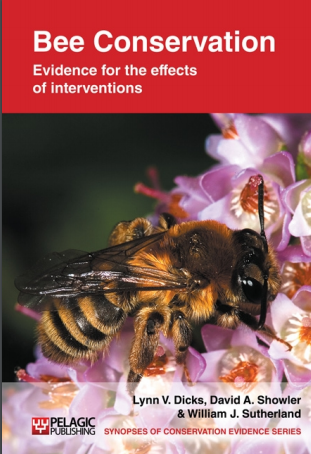Create patches of bare ground for ground-nesting bees
-
Overall effectiveness category Awaiting assessment
-
Number of studies: 5
View assessment score
Hide assessment score
How is the evidence assessed?
-
Effectiveness
not assessed -
Certainty
not assessed -
Harms
not assessed
Study locations
Supporting evidence from individual studies
Three scrapes with vegetation removed at Headley Heath, Surrey, England were being used by ground-nesting bees two or three years after they were created (Edwards 1996). The average densities of burrows attributed to ground-nesting bees and wasps were 2.3, 1.2 and 2.3 burrows/m2 for small (500 m2), medium (2,500 m2) and large (5,000 m2) scrapes respectively.
Study and other actions testedNest density of ground-nesting bees and wasps was increased by removing plant cover, or digging and raising soil, in trial plots at five sandy grassland sites in Baden-Württemberg, southwest Germany in 1992, relative to five control sites (Wesserling & Tscharntke 1995). Digging and raising soil was more effective at increasing nest density. Raking was not very effective, because it generated a dense plant cover.
Study and other actions testedA study of artificially made scrapes on three lowland heaths in West Sussex, England (Edwards 1998) found between two and eight solitary bee species using the scrapes one to four years after they were created, with up to five of the species actively nesting.
Study and other actions testedSeverns (2004) created 1 m2 plots of mostly bare ground whilst planting seeds of the endangered legume Kincaid's lupine Lupine sulphureus spp. kincaidii, in an upland prairie restoration project in Oregon, USA. The bare ground was colonised by an increasing number of nesting solitary bees, mostly of the common species Lasioglossum anhypops, over the following three years. Three years later, there were 320 nests over 30 plots.
Study and other actions testedFour shallow bays (3 x 5 m), with a rear vertical face (30 cm), were dug to attract ground-nesting bees and wasps at Shotover Hill, a heath degraded due to a long-term lack of grazing in Oxfordshire, southern England. All four bays were colonised in the first year with 80 solitary bee and wasp species recorded in the following three years (Gregory & Wright 2005).
Study and other actions tested
Where has this evidence come from?
List of journals searched by synopsis
All the journals searched for all synopses
This Action forms part of the Action Synopsis:
Bee Conservation
Bee Conservation - Published 2010
Bee Synopsis





)_2023.JPG)














